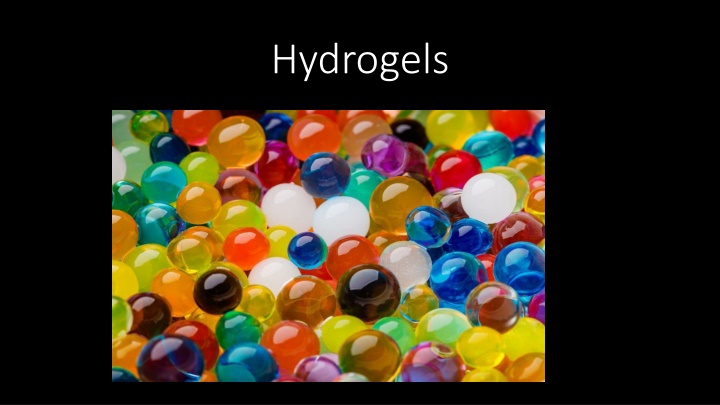
The Versatile Applications of Hydrogels in Biomedical Science
Discover the potential of hydrogels in biosensors, drug delivery, tissue engineering, and more. Learn about the unique properties of hydrogels, ongoing research, and the need for advanced hydrogel technologies.
Download Presentation

Please find below an Image/Link to download the presentation.
The content on the website is provided AS IS for your information and personal use only. It may not be sold, licensed, or shared on other websites without obtaining consent from the author. If you encounter any issues during the download, it is possible that the publisher has removed the file from their server.
You are allowed to download the files provided on this website for personal or commercial use, subject to the condition that they are used lawfully. All files are the property of their respective owners.
The content on the website is provided AS IS for your information and personal use only. It may not be sold, licensed, or shared on other websites without obtaining consent from the author.
E N D
Presentation Transcript
HYDROGELS Hydrogels are hydrophilic, three-dimensional networks that are able to absorb large quantities of water or biological fluids, and thus have the potential to be used as prime candidates for biosensors, drug delivery vectors, and carriers or matrices for cells in tissue engineering. Hydrogels, cross-linked 3D networks of hydrophilic polymer chains, are capable of holding large amounts of water due to their hydrophilic structure. Thus, the hydrogel networks can extensively swell in water media. Since water is the greatest component of the human body, a hydrogel, which can absorb large quantities of water, is considered to have great potential when applied for biomedical purposes.
Recently, wide investigation has been going on into the feasibility of applying hydrogels in fields including tissue engineering, drug delivery, self-healing materials, biosensors, and hemostasis bandages. Compared with other types of biomaterials, hydrogels have the advantages of increased biocompatibility, tunable biodegradability, properly mechanical strength, porous structure, and so on. However, due to the low mechanical strength and fragile nature of the hydrogels, the feasibility of applying hydrogels is still limited. Thus, novel hydrogels with stronger and more stable properties are still needed and remain an important direction for research.
A hydrogel is a three-dimensional (3D) network of hydrophilic polymers that can swell in water and hold a large amount of water while maintaining the structure due to chemical or physical cross-linking of individual polymer chains. Hydrogels were first reported by Wichterle and L m (1960). By definition, water must constitute at least 10% of the total weight (or volume) for a material to be a hydrogel. Hydrogels also possess a degree of flexibility very similar to natural tissue due to their significant water content. The hydrophilicity of the network is due to the presence of hydrophilic groups such as -NH2, -COOH, -OH, -CONH2, - CONH -, and -SO3H.
Hydrogels undergo a significant volume phase transition or gel-sol phase transition in response to certain physical and chemical stimuli. The physical stimuli include temperature, electric and magnetic fields, solvent composition, light intensity, and pressure, while the chemical or biochemical stimuli include pH, ions, and specific chemical compositions. However, in most cases such conformational transitions are reversible; therefore, the hydrogels are capable of returning to their initial state after a reaction as soon as the trigger is removed. The response of hydrogels to external stimuli is mainly determined by the nature of the monomer, charge density, pendant chains, and the degree of cross-linkage. The magnitude of response is also directly proportional to the applied external stimulus.
Classifications of hydrogels The literature reports a number of classifications of hydrogels and presents several views. Hydrogels are mainly formed from biopolymers and/or polyelectrolytes. Concerning definitions of hydrogel types, according to the source, hydrogels can be divided into those formed from natural polymers and those formed from synthetic polymers. Depending on the ionic charges on the bound groups, hydrogels may be cationic, anionic, or neutral. The types of cross-linking agents also can be the criteria for classification.
Hydrogels can be physical, chemical, or biochemical. Physical gels can undergo a transition from liquid to a gel in response to a change in environmental conditions such as temperature, ionic concentration, pH, or other conditions such as mixing of two components. Chemical gels use covalent bonding that introduces mechanical integrity and degradation resistance compared to other weak materials. In biochemical hydrogels, biological agents like enzymes or amino acids participate in the gelation process.
In situ hydrogel formation using chemical cross-linking and ionic interaction between alginate and calcium ions
DRUG DELIVERY USING HYDROGELS Hydrophilic polymeric networks that are capable of imbibing huge volumes of water and undergoing swelling and shrinkage suitably to facilitate controlled drug-release are called hydrogels. Their porosity and compatibility with aqueous environments make them highly attractive bio- compatible drug delivery vehicles
ADVANTAGES The unique physical properties of hydrogels have sparked particular interest in their use in drug delivery applications. Their highly porous structure can easily be tuned by controlling the density of cross-links in the gel matrix and the affinity of the hydrogels for the aqueous environment in which they are swollen. Their porosity also permits loading of drugs into the gel matrix and subsequent drug release at a rate dependent on the diffusion coefficient of the small molecule or macromolecule through the gel network. Indeed, the benefits of hydrogels for drug delivery may be largely pharmacokinetic specifically that a depot formulation is created from which drugs slowly elute, maintaining a high local concentration of drug in the surrounding tissues over an extended period, although they can also be used for systemic delivery..
Hydrogels are also generally highly biocompatible, as reflected in their successful use in the peritoneum and other sites in vivo. Biocompatibility is promoted by the high water content of hydrogels and the physiochemical similarity of hydrogels to the native extracellular matrix, both compositionally (particularly in the case of carbohydrate- based hydrogels) and mechanically. Biodegradability or dissolution may be designed into hydrogels via enzymatic, hydrolytic, or environmental (e.g. pH, temperature, or electric field) pathways; however, degradation is not always desirable depending on the time scale and location of the drug delivery device. Hydrogels are also relatively deformable and can conform to the shape of the surface to which they are applied. In the latter context, the muco- or bioadhesive properties of some hydrogels can be advantageous in immobilizing them at the site of application or in applying them on surfaces that are not horizontal
Limitations Despite these many advantageous properties, hydrogels also have several limitations. The low tensile strength of many hydrogels limits their use in load-bearing applications and can result in the premature dissolution or flow away of the hydrogel from a targeted local site. This limitation may not be important in many typical drug delivery applications (e.g. subcutaneous injection). More important, perhaps, are problems relating to the drug delivery properties of hydrogels. The quantity and homogeneity of drug loading into hydrogels may be limited, particularly in the case of hydrophobic drugs. The high water content and large pore sizes of most hydrogels often result in relatively rapid drug release, over a few hours to a few days. Ease of application can also be problematic; although some hydrogels are sufficiently deformable to be injectable, many are not, necessitating surgical implantation. Each of these issues significantly restricts the practical use of hydrogel-based drug delivery therapies in the clinic.
SUPERPOROUS HYDROGELS The slow swelling property made hydrogels useful in drug delivery, many applications required fast swelling of dried hydrogels. Fast swelling is usually done by making very small particles of dried hydrogels. One way of overcoming the slow absorption of water was to create pores that are interconnected to each other through out the hydrogel matrix. The interconnected pores allow for fast absorption of water by capillary force. A simple method of making porous hydrogel is to produce gas bubbles during cross linking polymerization of vinyl monomers.
SYNTHESIS OF SUPER POROUS HYDROGELS We have been interested in the synthesis of hydrogels with fast swelling kinetics and superabsorbent properties. To increase the water absorption rate, interconnected pores were introduced to the hydrogels. Since the pore size in the dried hydrogels is in the order of hundreds of micrometers, these hydrogels are called superporous hydrogels. Superporous hydrogels were synthesized by crosslinking polymerization of various vinyl monomers in the presence of gas bubbles formed by the chemical reaction of acid and NaHCO3.
The polymerization process was optimized to capture the gas bubbles inside the synthesized hydrogels. The use of the NaHCO3/acid system allowed easy control of timing for gelation and foam formation. We found that PF127 was the best foam stabilizer for most of the monomer systems used in our study. Scanning electron microscope (SEM) pictures showed interconnected pores forming capillary channels. The capillary channels, which were critical for fast swelling, were preserved during drying by dehydrating water swollen hydrogels with ethanol before drying. The ethanol dehydrated superporous hydrogels reached equilibrium swelling within minutes. The equilibrium swelling time could be reduced to less than a minute with the use of a wetting agent.
ELASTIC, SUPERPOROUS HYDROGEL Hydrogels having improved elasticity and mechanical strength properties are obtained by subjecting a hydrogel formulation containing a strengthening agent to chemical or physical crosslinking conditions subsequent to initial gel formation. Superporous hydrogels having improved elasticity and mechanical strength properties are similarly obtained whenever the hydrogel formulation is provided with a foaming agent. Interpenetrating networks of polymer chains comprised of primary polymer(s) and strengthening polymer(s) are thereby formed. The primary polymer affords capillary-based water sorption properties while the strengthening polymer imparts significantly enhanced mechanical strength and elasticity to the hydrogel or superporous hydrogel. Suitable strengthening agents can be natural or synthetic polymers, polyelectrolytes, or neutral, hydrophilic polymers.



![Lec [2] Health promotion](/thumb/274962/lec-2-health-promotion-powerpoint-ppt-presentation.jpg)